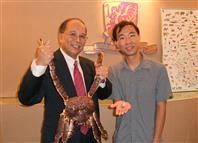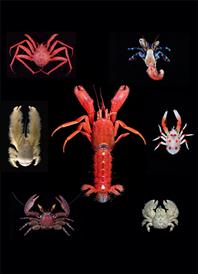When you are enjoying a delicious meal of Alaskan or Japanese king crabs, you probably are not aware of the fact that what you are eating, scientifically speaking, are not really ‘crabs’, in the same way as are the Chinese mitten crab, the common mud crab and other swimming crabs.
Prof. Chu Ka-hou, director of the School of Life Sciences and Simon F.S. Li Marine Science Laboratory, worked in collaboration with his PhD student Dr. Tsang Ling-ming, Prof. Chan Tin-yam from Taiwan Ocean University, and Dr. Shane Ahyong from the Australian Museum in Sydney. They confirmed that king crabs are actually close relatives of hermit crabs, and belong to a group known as the anomurans, a group of crustaceans including hermit crabs and other forms that have a crab-like (such as the king crabs and porcelain crabs) or lobster-like (called squat lobsters) appearance. Compared to true crabs, the last pair of legs of anomurans is very small and their tails are often folded under the body.
Their study based on new evidence from DNA analysis shows that the tiny hermit crab, which generally weighs less than a quarter of a pound, is the ancestor of not only the king crab, a creature that may weigh more than 18 pounds with a limb span reaching six feet, but also that of almost all other anomurans.
Professor Chu said, ‘We got this interesting result by DNA sequence analysis of nuclear protein-coding gene markers we newly developed for the crustaceans. The crab-like and squat lobster forms evolved more than once from their hermit crab ancestors. This fact shows that the body plan of the hermit crab is highly flexible and parallel evolution to crab-like forms is common in this group.’
Parallel evolution refers to the independent evolution of similar characteristics, in this case the different crab-like forms from hermit crabs. Moreover, the true crabs and crab-like anomurans are also examples of parallel evolution. This example also shows that similarity in appearances between animals can be a deceptive indicator of relatedness. This study has just been published in Systematic Biology, the top journal in the field of evolutionary biology, in August 2011.





































































































































































Social Bookmarks